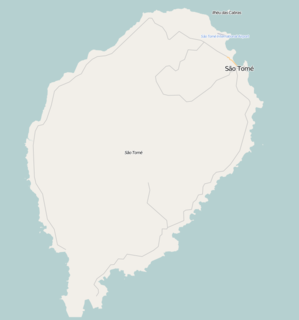| Praia Inhame | |
|---|---|
 Praia Inhame | |
| Location | Southern island of São Tomé, São Tomé and Príncipe near Porto Alegre |
| Coordinates | 0°01′29″N6°31′11″E / 0.0248°N 6.5197°E Coordinates: 0°01′29″N6°31′11″E / 0.0248°N 6.5197°E |
| Geology | Beach |
Praia Inhame is a beach in the southernmost part of the island of São Tomé in São Tomé and Príncipe. It lies directly east of the southernmost point of the island, Ponta Homem da Capa, and 2 km southwest of the village Porto Alegre. There is an eco lodge near the beach. The Canal das Rolas separates it from Ilhéu das Rolas.

São Tomé Island, at 854 km2 (330 sq mi), is the largest island of São Tomé and Príncipe and is home to about 157,000 or 96% of the nation's population. The island is divided into six districts. It is located 2 km north of the equator.

São Tomé and Príncipe, officially the Democratic Republic of São Tomé and Príncipe, is an island country in the Gulf of Guinea, off the western equatorial coast of Central Africa. It consists of two archipelagos around the two main islands of São Tomé and Príncipe, about 140 kilometres apart and about 250 and 225 kilometres off the northwestern coast of Gabon, respectively.

Porto Alegre is a village in Caué District on São Tomé Island in São Tomé and Príncipe. Its population is 795. Porto Alegre lies 2.5 km northeast of the southernmost point of São Tomé Island, Ponta Homem da Capa. It is 1.5 km west of Ponta Baleia, 17 km southwest of São João dos Angolares and 40 km southwest of the capital São Tomé. Across the Canal das Rolas lies the Ilhéu das Rolas. On the east side of Ponta Homem da Capa is the beach Praia Inhame. The plantation complex Roça de Porto Alegre was established around 1890 by Jacinto Carneiro de Sousa e Almeida. The oldest preserved building dates from 1918.
A new species of snake was found near the beach in 2017. It was named Naja peroescobari , named after the 15th century Portuguese explorer Pero Escobar. [1]
Naja peroescobari is a species of snakes in the family Elapidae. It was previously considered as a forest cobra introduced by the Portuguese to limit proliferations by rats. However, it was recently discovered to be a different species, endemic to the island of São Tomé, São Tomé and Príncipe. The holotype was found near the beach Praia Inhame, southwest of Porto Alegre. It was named by Ceríaco et al. after the Portuguese explorer Pêro Escobar. Naja peroescobari is one of the few predators on the island that faces terrestrial mammals such as the black rat and the weasel.







